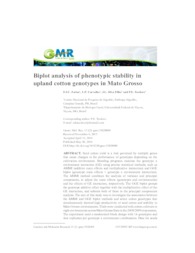Biplot analysis of phenotypic stability in upland cotton genotypes in Mato Grosso.
Biplot analysis of phenotypic stability in upland cotton genotypes in Mato Grosso.
Autoria: FARIAS, F. J. C.; CARVALHO, L. P. de; SILVA FILHO, J. L. da; TEODORO, P. E.
Resumo: Seed cotton yield is a trait governed by multiple genes that cause changes in the performance of genotypes depending on the cultivation environment. Breeding programs examine the genotype x environment interaction (GE) using precise statistical methods, such as AMMI (additive main effects and multiplicative interaction) and GGE biplot (genotype main effects + genotype x environment interaction). The AMMI method combines the analysis of variance and principal components, to adjust the main effects (genotypes and environments) and the effects of GE interaction, respectively. The GGE biplot groups the genotype additive effect together with the multiplicative effect of the GE interaction, and submits both of these to the principal components analysis. The aim of this study was to investigate the association between the AMMI and GGE biplot methods and select cotton genotypes that simultaneously showed high productivity of seed cotton and stability in Mato Grosso environments. Trials were conducted with cotton cultivars in eight environments across Mato Grosso State in the 2008/2009 crop season. The experiment used a randomized block design with 16 genotypes and four replicates per genotype x environment combination. Data for seeds cotton productivity were analyzed by AMMI and GGE biplot methods. Both methods were concordant in the discrimination of environments and genotypes for phenotypic stability. The genotypes BRS ARAÇÁ and LD 05 CV had high seed cotton productivity and phenotypic stability, and could be grown in all environments across Mato Grosso State.
Ano de publicação: 2016
Tipo de publicação: Artigo de periódico
Unidade: Embrapa Algodão
Palavras-chave: Algodão, Cotton, Genótipo, Gossypium hirsutum
Observações
1 - Por padrão são exibidas publicações dos últimos 20 anos. Para encontrar publicações mais antigas, configure o filtro ano de publicação, colocando o ano a partir do qual você deseja encontrar publicações. O filtro está na coluna da esquerda na busca acima.
2 - Para ler algumas publicações da Embrapa (apenas as que estão em formato ePub), é necessário ter, no celular ou computador, um desses softwares gratuitos. Sistemas Android: Google Play Livros; IOS: iBooks; Windows e Linux: software Calibre.
Acesse outras publicações
Acesse a Base de Dados da Pesquisa Agropecuária (BDPA) para consultar o acervo completo das bibliotecas da Embrapa.

